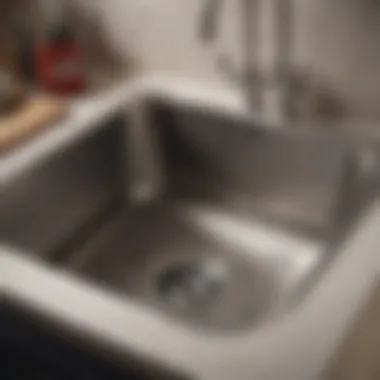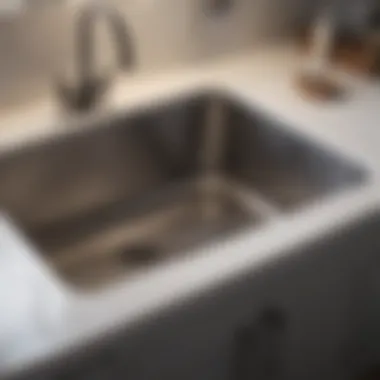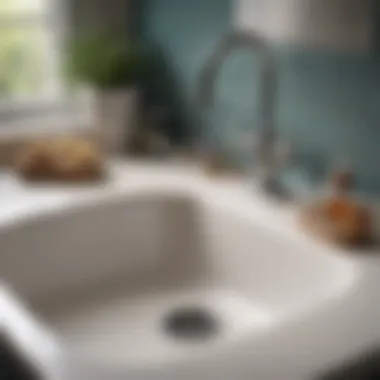Efficient Methods for Unclogging a Laundry Sink Drain: A Detailed Guide


The maintenance of a household encompasses various facets, with the plumbing system constituting a fundamental element. Addressing a clogged laundry sink drain is a common concern for homeowners, as it can impede the daily functioning of the household. By understanding the root causes of blockages and implementing effective strategies to alleviate them, individuals can ensure optimal drainage in their laundry area.
Section 1: Understanding Common Causes of Clogs
Before embarking on the journey of unclogging a laundry sink drain, it is imperative to grasp the common culprits behind such obstructions. Accumulation of debris, such as soap scum, hair, and lint, is a prevalent cause of clogs in sink drains. Additionally, grease and food particles washed down the drain can congeal and restrict proper water flow. By identifying these common sources of blockages, individuals can proactively take measures to prevent future clogs.
Subsection 1: Soap Scum and Residue Build-Up
Soap scum, a byproduct of using soaps and detergents, can adhere to the walls of the drain pipe over time, forming a sticky residue that traps debris and impedes water flow. This build-up of residue not only leads to slow drainage but can also result in complete blockages if left unaddressed. Understanding the nature of soap scum accumulation is crucial in devising effective solutions for unclogging the laundry sink drain and maintaining optimal plumbing function.
Section 2: Employing Effective Solutions for Unclogging
Once the underlying causes of clogged laundry sink drains are identified, it is essential to explore effective solutions to restore proper drainage. From utilizing household ingredients like baking soda and vinegar to employing plungers or drain snakes, a multitude of methods can be employed to alleviate blockages. Furthermore, the use of enzymatic cleaners or physically removing the blockage with plumbing tools can be effective strategies in unclogging the sink drain.
Subsection 2: Using Natural Remedies
Natural remedies play a significant role in unclogging laundry sink drains while being environmentally friendly and cost-effective. The foaming action of baking soda and vinegar can help break down debris and dislodge blockages, providing a gentle yet efficient solution for clogged drains. Additionally, the use of hot water flushes can aid in clearing minor obstructions, restoring the smooth flow of water in the sink drain.
Section 3: Maintenance Tips for Optimal Drainage
To ensure long-term functionality of the laundry sink drain and prevent recurrent clogs, implementing preventive maintenance measures is imperative. Regularly flushing the drain with hot water, installing drain filters to trap debris, and avoiding the disposal of grease and solid materials down the drain are essential practices for maintaining optimal drainage. By incorporating these simple yet effective tips into the regular maintenance routine, individuals can uphold the efficiency of their laundry sink drain and minimize the likelihood of clogs.
Subsection 3: Preventive Measures for Sustained Drainage
Preventive measures serve as a preemptive approach to mitigating clogs in the laundry sink drain, reducing the need for frequent unclogging interventions. By staying vigilant towards potential blockage triggers and adopting proactive measures such as scheduled drain maintenance, homeowners can uphold the longevity and functionality of their plumbing system. Implementing these preventive tips can not only prevent inconveniences caused by clogged drains but also contribute to the overall efficiency of the household plumbing infrastructure.
Introduction


In the realm of household maintenance, few things are as inconvenient and bothersome as a clogged laundry sink drain. This article serves as a guiding light, illuminating the path to resolving this common issue effectively and efficiently. A clogged laundry sink drain not only disrupts daily routines but can also lead to more significant plumbing problems if left unattended. By understanding the key indicators of a blockage, homeowners can address the issue promptly, saving time, money, and potential headaches.
Furthermore, with the plethora of DIY solutions and preventive measures outlined in this comprehensive guide, individuals can equip themselves with the knowledge and tools necessary to tackle clogs head-on. From simple techniques like plunging and using household items such as baking soda and vinegar to more advanced methods like employing a drain snake, this article covers a wide array of strategies tailored to various levels of expertise.
By delving into the common causes of clogs and exploring the associated risk factors, readers will gain a holistic view of the intricacies surrounding a clogged laundry sink drain. This knowledge not only empowers individuals to address current blockages but also equips them with insights to prevent future occurrences. With an emphasis on both practical solutions and proactive maintenance, this guide aims to be a valuable resource for homeowners looking to maintain a smoothly functioning laundry area.
In essence, this article transcends mere troubleshooting; it serves as a beacon of expertise, guiding readers through a journey of understanding, problem-solving, and maintenance. By imparting practical tips and expert insights, this guide aims to alleviate the stress and inconvenience often linked to a clogged laundry sink drain, offering readers a comprehensive toolkit for restoring optimal drainage and promoting long-term plumbing health.
Understanding the Issue
Clogged laundry sink drains can be a major inconvenience, disrupting daily household routines. The presence of a blockage in the drain can lead to water accumulating in the sink, causing unpleasant odors and potential overflow. Understanding the issue is crucial in this article as it sets the foundation for addressing the problem effectively. By exploring the signs, causes, and associated risks of a clogged laundry sink drain, readers will acquire knowledge that is essential for maintaining a functional drainage system in their homes.
Signs of a Clogged Laundry Sink Drain
Recognizing the early signs of a clogged laundry sink drain is key to prompt intervention. Water draining slowly or not at all is a common indicator of a blockage. Additionally, gurgling sounds coming from the drain, foul odors emanating from the sink, and water pooling around the drain are all signs that point towards a potential clog. Ignoring these signs can lead to more severe plumbing issues, making it imperative to address the problem promptly.
Common Causes of Clogs
Various factors can contribute to the blockage of a laundry sink drain. Accumulation of dirt, soap scum, hair, and debris over time is a prevalent cause of clogs. Food particles, excessive detergent residue, and foreign objects accidentally falling into the drain can also obstruct the pipes. Understanding these common causes can help individuals adopt preventive measures to minimize the risk of encountering a clogged laundry sink drain.
Risk Factors Associated
A clogged laundry sink drain poses several risks that extend beyond inconvenience. Standing water in the sink can create a breeding ground for bacteria and mold, leading to unsanitary conditions in the household. Moreover, prolonged blockages may exert pressure on the pipes, potentially causing leaks or pipe damage. Addressing the risk factors associated with a clogged drain not only ensures the hygiene and functionality of the drainage system but also helps in safeguarding the overall plumbing infrastructure of the home.
DIY Solutions
In the realm of household maintenance, having a toolkit of DIY solutions to tackle unforeseen challenges is indispensable. When it comes to addressing a clogged laundry sink drain, these DIY methods not only save time and money but also empower homeowners to take charge of their living space's functionality. Embracing the DIY ethos fosters a sense of independence and self-sufficiency, qualities greatly valued in today's fast-paced world. Furthermore, DIY solutions often involve simple yet effective techniques that can be implemented without the need for professional assistance, promoting a hands-on approach to home care. Amidst the hustle and bustle of daily life, being equipped with DIY solutions for common household issues like clogged sink drains can be a real game-changer.
Using a Plunger


When faced with a stubborn clog in your laundry sink drain, reaching for a plunger can prove to be a tried-and-true solution. The process of using a plunger involves creating a tight seal around the drain opening and exerting pressure to dislodge the blockage. This physical force generated by the plunging action helps to break apart debris and promote the free flow of water through the drain pipes. Utilizing a plunger is a straightforward yet effective method that can yield successful results in many cases of sink blockages. However, it is essential to ensure that the plunger is of the correct size and type for the specific drain to maximize its effectiveness.
Applying Baking Soda and Vinegar
For those inclined towards natural and environmentally friendly solutions, the combination of baking soda and vinegar offers a gentle yet potent means of unclogging a laundry sink drain. The reaction between these two household staples creates fizzing and bubbling, which can help dislodge debris and clear minor blockages in the drain pipe. This chemical-free method not only serves as an eco-conscious alternative to harsh drain cleaners but also leaves behind a clean and fresh scent. The process of applying baking soda and vinegar is simple yet effective, making it a popular choice for individuals seeking non-toxic methods to maintain their home's plumbing system.
Clearing the P-Trap
When conventional methods fall short in resolving a clogged laundry sink drain, turning attention to the P-trap can often reveal the root of the issue. The P-trap, a U-shaped pipe located beneath the sink, is designed to trap debris and prevent sewer gases from entering the household. However, this component can also become a catchment for hair, soap scum, and other substances, leading to clogs over time. Clearing the P-trap involves disassembling the pipe carefully, removing any accumulated debris, and reassembling it securely. This process may require some basic plumbing skills and knowledge but can prove to be a highly effective approach to unclogging a stubborn drain. By addressing the P-trap, homeowners can tackle the clog at its source and ensure long-term drainage efficiency in their laundry area.
Advanced Techniques
In this segment of the comprehensive guide on how to unclog a laundry sink drain, we delve into the pivotal aspect of advanced techniques. When DIY solutions fall short, turning to advanced methods becomes inevitable. Advanced techniques play a crucial role in tackling stubborn clogs that resist common remedies. These methods are essential for maintaining optimal drainage in your laundry area.
One key component of advanced techniques is using a drain snake. This tool is designed to navigate through pipes, breaking down tough clogs that plagues your sink's drainage system. By inserting the drain snake into the pipe and maneuvering it carefully, you can dislodge obstructions that hinder water flow. It's a sophisticated yet effective way to address severe clogs that ordinary methods cannot adequately resolve.
Chemical drain cleaners represent another facet of advanced techniques. These potent solutions work by dissolving organic matter, hair, grease, and other debris accumulated in the pipes. While effective, caution must be exercised when using chemical drain cleaners due to their harsh nature and potential to damage pipes. It is advisable to follow instructions meticulously and wear protective gear to prevent any mishaps during the cleaning process.
Preventive Measures
In our exploration of how to unclog a laundry sink drain comprehensively, preventive measures emerge as a crucial aspect to maintain optimal drainage efficiency in your laundry area. By implementing these preventive steps, you can proactively reduce the occurrence of clogs and minimize the need for frequent interventions. Preventive measures not only save you time and effort but also contribute to the longevity of your plumbing system.
One of the key preventive measures is practicing regular maintenance to keep your laundry sink drain free from build-up and obstructions. By adhering to a routine maintenance schedule, such as monthly drain flushing with hot water, you can prevent the accumulation of soap scum, grease, and other debris that often lead to clogs. Additionally, utilizing sink strainers to catch hair, lint, and larger particles before they enter the drain can significantly decrease the likelihood of blockages.
Furthermore, being mindful of the materials that go down your laundry sink plays a vital role in preventive care. Avoid disposing of coffee grounds, cooking oil, solid food particles, and harsh chemicals down the drain, as these substances can congeal, solidify, or corrode the pipes over time, creating blockages. By following these prudent practices, you can safeguard your laundry sink drain from unnecessary distress and ensure smooth drainage operations for years to come.
Regular Maintenance Practices
Engaging in regular maintenance practices is instrumental in upholding the functionality and longevity of your laundry sink drain. Establishing a consistent maintenance routine not only prevents clogs but also promotes overall hygiene and efficiency in your laundry area. One effective maintenance practice is the periodic inspection of your drain system for any signs of slow drainage, unusual odors, or gurgling sounds, which could indicate an impending clog. Identifying and addressing minor issues early on can prevent major blockages and costly repairs in the future.


Moreover, incorporating a biodegradable enzyme cleaner into your maintenance regimen can help break down organic matter and prevent the accumulation of soap scum and grease within the pipes. These environmentally-friendly cleaners are gentle on your plumbing system while effectively maintaining clear and odor-free drains. Additionally, regularly cleaning the P-trap to remove trapped debris and replenishing the water seal can prevent sewer gas from entering your home and ensure proper drainage flow.
Consistency is key when it comes to regular maintenance practices for your laundry sink drain. By dedicating time and attention to these simple yet impactful tasks, you can preserve the integrity of your plumbing system and enjoy uninterrupted functionality in your laundry area.
Avoiding Certain Materials
In the realm of preventive care for your laundry sink drain, avoiding certain materials is paramount to prevent unwanted clogs and maintain optimal drainage performance. Several common household items and substances pose a significant risk to your plumbing system when disposed of improperly, leading to blockages and potential damage. By familiarizing yourself with these prohibited materials and exercising caution in their disposal, you can protect your drain system from unnecessary complications.
Materials such as coffee grounds, grease, fat, and oil should never be poured down the drain, as they can solidify and adhere to the pipe walls, impeding water flow and fostering clogs. Similarly, fibrous materials like vegetable peels, fruit pits, and starchy foods should be discarded in the trash rather than rinsed down the sink, as they can wrap around the pipes and cause blockages over time. Harsh chemicals, such as bleach, drain cleaners, and paint thinners, should also be avoided, as they can corrode the pipes and harm the environment.
By exercising vigilance in what you allow into your laundry sink drain, you can mitigate the risk of clogs and protect the integrity of your plumbing system. Simple yet intentional decisions in material disposal can make a significant difference in the longevity and efficiency of your drainage infrastructure.
Professional Assistance
In the realm of addressing stubborn clogs in laundry sink drains, the option of seeking professional assistance emerges as a beacon of hope for homeowners grappling with persistent drainage issues. While the previous sections have admirably covered DIY solutions and preventive measures, there are instances where the expertise of professionals becomes indispensable. This section aims to shed light on the pivotal role professional assistance plays in ensuring the seamless functionality of laundry sink drains.
Embracing professional assistance entails enlisting the services of skilled plumbers or contractors well-versed in resolving intricate plumbing woes. These professionals bring a wealth of experience and specialized tools to the table, allowing them to diagnose and rectify drainage problems with unparalleled efficiency. By entrusting the task to adept professionals, homeowners can rest assured that their laundry sink drain issues will be expertly tackled, sparing them the hassle and frustration of navigating complex plumbing intricacies.
One of the key benefits of opting for professional assistance is the assurance of a thorough and lasting solution to stubborn clogs. Professional plumbers possess a deep understanding of the underlying causes of drainage obstructions, enabling them to implement targeted and effective remedies. Moreover, their proficiency in using advanced techniques and equipment elevates the quality of workmanship, leading to durable results that stand the test of time. In essence, professional assistance not only resolves existing clogs but also prevents future blockages, promoting a smoothly functioning laundry sink drain over the long haul.
When contemplating the prospect of professional assistance, it is essential for homeowners to weigh certain considerations. Factors such as the reputation of the service provider, their track record in handling similar plumbing issues, and the cost implications of hiring professionals should be carefully evaluated. Striking a balance between quality service and affordability is paramount in ensuring a satisfactory outcome. By conducting research, seeking recommendations, and engaging in transparent communication with service providers, homeowners can make well-informed decisions regarding professional assistance for unclogging their laundry sink drain.
In essence, while DIY solutions and preventive measures hold merit in addressing minor clogs and maintaining optimal drain health, the option of professional assistance emerges as a reliable ally in combating persistent or complex drainage challenges. By understanding the benefits, considerations, and nuances associated with professional assistance, homeowners can navigate the realm of laundry sink drain maintenance with confidence and efficacy.
Conclusion
In the realm of household maintenance, the often-overlooked laundry sink drain takes center stage in its importance in ensuring the smooth operation of a crucial area in any home. Throughout this comprehensive guide on how to unclog a laundry sink drain, the significance of proactive maintenance and timely intervention becomes abundantly clear. By adhering to the insights divulged in this article, homeowners can not only prevent inconvenient clogs but also preserve the integrity of their plumbing system, averting more costly repairs down the line.
One of the key takeaways emphasized in this guide is the empowerment it grants to readers in tackling a common yet potentially disruptive issue efficiently. By decoding the signs of a clogged laundry sink drain, understanding the common causes, and implementing a range of DIY and advanced solutions outlined here, individuals can nurture a sense of self-sufficiency in maintaining their living spaces.
Furthermore, the discussion on preventive measures sheds light on how a little attention and care can go a long way in forestalling future complications. Whether it involves periodic checks or being mindful of the materials that enter the drain, the preventive strategies shared in this guide are geared towards fostering long-term plumbing health.
For those contemplating professional assistance, this guide serves as a compass, guiding individuals on when it might be prudent to seek the expertise of a professional plumber. It underscores the importance of recognizing limitations and understanding when DIY solutions may no longer suffice, promoting a pragmatic approach to problem-solving within the realms of home maintenance.
In essence, the exploration of unclogging a laundry sink drain extends beyond mere practicality; it delves into cultivating a mindful and responsible attitude towards homeownership. By navigating through the multifaceted facets of maintaining a functional laundry sink drain, individuals can enhance not only the efficiency of their home systems but also their overall sense of domestic stewardship and competence.



